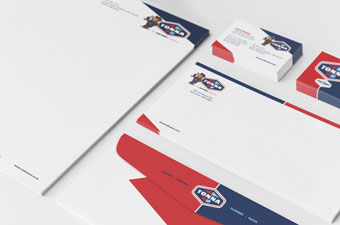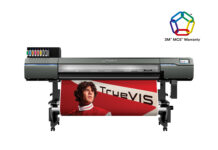The saying “first impressions are everything” has been around for a long time, and it’s because there’s truth in the platitude—for people and for businesses.
For a business, its first impression comes from its logo and branding, which is something sign shops are well positioned to offer.
Dan Antonelli, CEO and creative director of Graphic D-Signs, Inc., knows a lot about branding. His roots are in the sign industry, where he worked in a sign shop as a teen and learned the lettering and pinstriping trades from a second-generation sign painter.
In college, Antonelli earned a degree in advertising/communications, and he worked as a graphic designer after graduating. However he still missed working with small companies as he had in the sign business, so he launched Graphic D-Signs, a design company, out of his basement in 1995.
Two years later, he had enough business to quit his day job and focus fully on the design firm. Today Graphic D-Signs operates out of an office with fourteen employees.
“When I started the company, I thought that businesses needed more than just signs,” says Antonelli. “I also felt that they needed things like branding, a logo, business cards, and stationery.
“So I always had an idea, this concept, that a small business could really benefit from one source to keep everything coordinated.”
Over the last twenty years, Antonelli has branded about one thousand businesses and written three books about building a brand. “One of the things that we talk about in the book [his most recent, Building a Big Small Business Brand] is this concept called the ‘brand promise.’ And in layman’s terms, that’s basically what a brand communicates to the average viewer and what assumptions they make on that brand should they know nothing else about that particular company,” he says. “It’s all about building that image and giving the consumer a rationale to believe that the deliverable they’re going to get from one company is better than the next.
“And a lot of that just drives from the brand.”
Getting Started
So how can a sign shop get involved with branding?
One of the first things a shop should consider is its own image. What type of message is it putting out to the public through its branding and logo?
“What are you projecting? What are you putting out on the street that is going to make me, as a business owner, believe that you can take care of my brand?” asks Antonelli. “A lot of sign companies are so busy doing all their other clients’ work that they neglect their own.
“But it’s really hard to sell branding when you don’t embrace the same philosophies.”
If the outward appearance of the shop is projecting the right image, then it’s time to focus on the sale within the shop.
Antonelli recommends shifting focus away from selling commodities and over to selling service-based design. He says shops should ask, “What can I give to that client at my shop that he can’t get somewhere else?” Oftentimes the answer is expertise.
Design expertise is not something a customer can get from just anywhere, and shops should capitalize on their skills to build up new profits.
Shops should also make sure customers know and understand what branding and logo design actually is. Illustrations and examples can go a long way in sealing the deal. “What I always try to recommend for sign companies is to really illustrate to the small business owner the concept of what a brand entails,” says Antonelli.
This illustration can include the use of case studies that demonstrate the importance of a logo or how branding is integrated into a business’ signage, car wraps, business cards, etc. “When they can visualize what a brand signifies, it’s easier to sell it,” says Antonelli.
 Design Considerations
Design Considerations
Once the sale is made, the consultation and design process begins. There are a number of considerations a shop must keep in mind when designing.
Know the audience. Consulting with the client on what they like is an important part of the design process. However shops should remember that the brand is being designed for the business’ audience, not the business itself.
“You certainly want to get information about demographics. You want to find out who it is that you’re trying to appeal to with this branding,” says Antonelli. “But it’s also equally important to point out to them that you’re not really there to design a logo for them. You’re there to design a logo for who their audience is.”
Media types. Part of the design process is making sure the brand is integrated and coordinated across all of the touch points a consumer may have with a company (which can include uniforms, business cards, vehicles, signs, and more). It’s important that all of these elements present a unified brand experience.
When considering the different types of media the brand will touch, design the logo for the primary media type.
“We always try to make sure that the brands we create are first going to work for the most important media that it’s intended in. For a lot of our clients, it’s actually their vehicles or an outdoor sign that may live in front of their business,” explains Antonelli.
Distance legibility is a big factor, and designing for the primary media type can help resolve some of those issues. “You can design a great logo that works in an outdoor realm, and it will always work well on print and Web,” he says, “but the same isn’t true going the other way around.”
Rebranding
Another sales opportunity comes in the form of redesigning existing branding and logos.
Companies may or may not be aware of the need for a change, and it is up to the sign shop to convince them of the need for a rebrand, which can be a tough sell as many companies become attached to their brand.
“Old brands are like warm blankets to small business owners,” says Antonelli. “They’ve seen it for so long and feel comfortable with it, and they’re afraid of what’s around the corner.”
Companies that have been successful even with bad branding are an especially hard sell. “Success in spite of a poor brand is not a valid reason to perpetuate it,” says Antonelli. “I say, ‘Imagine how much more success you might have had with a better brand.’”
So how can a sign shop convince a business they need a branding revamp? Answer: The same way they sell their design capabilities to any customer—through examples.
“Sometimes you have to get them over that fear, and we try to do that, again, by using case studies,” explains Antonelli.
Explaining how a rebrand is rolled out can also put a business at ease about the process. Typically the things that are the easiest to replace—uniforms, Web sites, business cards, etc.—are rolled out with new branding. The other media types are replaced more slowly.
“There’s going to be a period of time when you have the old brand and the new brand,” says Antonelli. “And as things get used or come out of service, you replace it.”
Pricing
One of the big questions a sign shop faces in all aspects of the business is pricing, and branding is no different. At the very least, a shop should bill at its hourly rate for the time spent designing and creating files.
But what about compensation for the worth of the brand itself—something that is hard to measure since it’s forward-looking?
Depending on analysis of the competition, the brand integration, etc., a shop may choose to tack on additional costs to the price of the work.
No matter what the price, branding, and logo design can be a lucrative avenue for a sign shop.
By Ashley Bray
Photos: Graphic D-Signs











